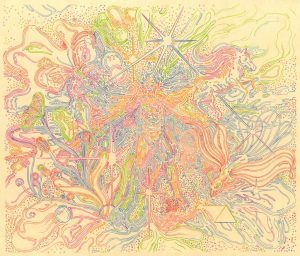Tom Bissell in The New York Times:
 Well, why does anyone take drugs? The simplest answer is that drugs are generally fun to take, until they aren’t. But psychedelics are different. They don’t drape you in marijuana’s gauzy haze or imbue you with cocaine’s wintry, italicized focus. They’re nothing like opioids, which balance the human body on a knife’s edge between pleasure and death. Psychedelics are to drugs what the Pyramids are to architecture — majestic, ancient and a little frightening. Pollan persuasively argues that our anxieties are misplaced when it comes to psychedelics, most of which are nonaddictive. They also fail to produce what Pollan calls the “physiological noise” of other psychoactive drugs. All things considered, LSD is probably less harmful to the human body than Diet Dr Pepper.
Well, why does anyone take drugs? The simplest answer is that drugs are generally fun to take, until they aren’t. But psychedelics are different. They don’t drape you in marijuana’s gauzy haze or imbue you with cocaine’s wintry, italicized focus. They’re nothing like opioids, which balance the human body on a knife’s edge between pleasure and death. Psychedelics are to drugs what the Pyramids are to architecture — majestic, ancient and a little frightening. Pollan persuasively argues that our anxieties are misplaced when it comes to psychedelics, most of which are nonaddictive. They also fail to produce what Pollan calls the “physiological noise” of other psychoactive drugs. All things considered, LSD is probably less harmful to the human body than Diet Dr Pepper.
Disclaimer aside, nothing in Pollan’s book argues for the recreational use or abuse of psychedelic drugs. What it does argue is that psychedelic-aided therapy, properly conducted by trained professionals — what Pollan calls White-Coat Shamanism — can be personally transformative, helping with everything from overcoming addiction to easing the existential terror of the terminally ill. The strange thing is we’ve been here with psychedelics before.
LSD was first synthesized (from a grain fungus) in 1938, by a chemist working for the Swiss pharmaceutical firm Sandoz. A few years later, not having any idea what he’d created, the chemist accidentally dosed himself and went on to have a notably interesting afternoon. With LSD, Sandoz knew it had something on its hands, but wasn’t sure what. Its management decided to send out free samples to researchers on request, which went on for more than a decade. By the 1950s, scientists studying LSD had discovered serotonin, figured out that the human brain was full of something called neurotransmitters and begun inching toward the development of the first antidepressants. LSD showed such promise in treating alcoholism that the A.A. founder Bill Wilson considered including LSD treatment in his program. So-called magic mushrooms — and the mind-altering psilocybin they contain — arrived a bit later to the scene, having been reintroduced to the Western world thanks to a 1957 Life magazine article, but they proved just as rich in therapeutic possibilities.
More here.
